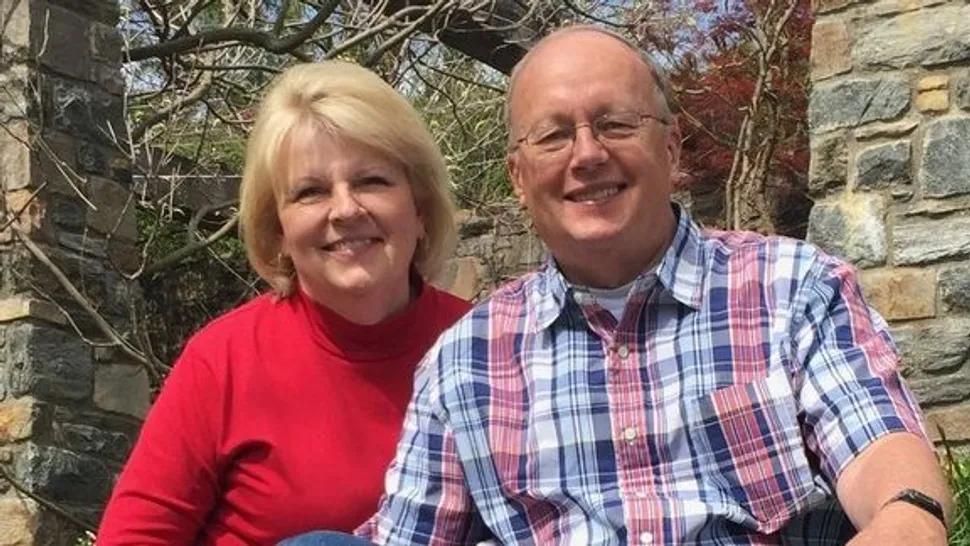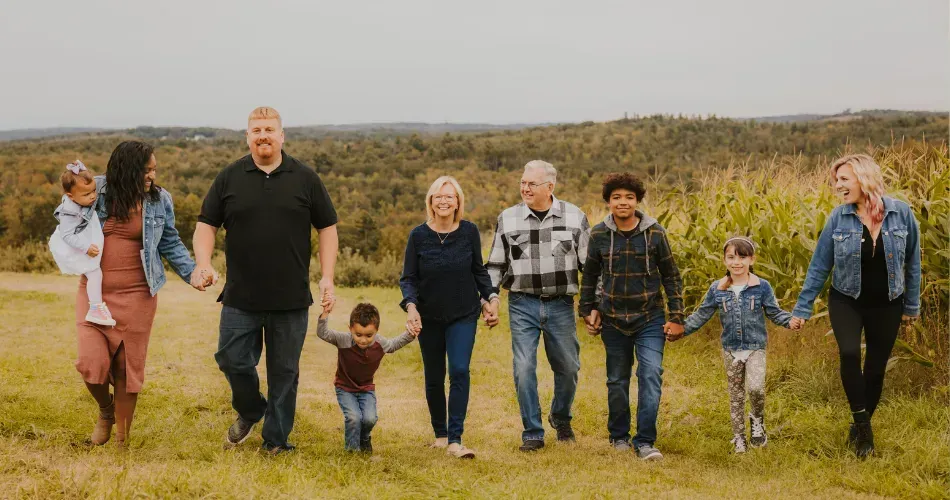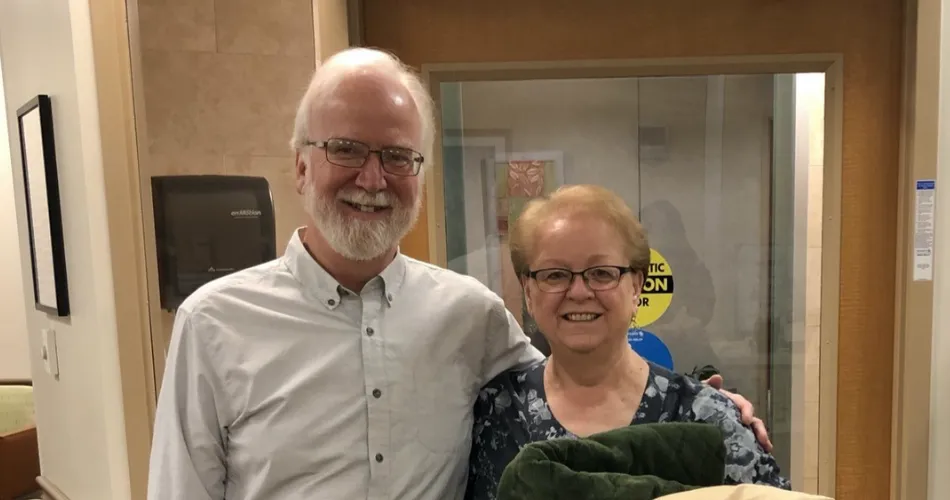John and Ann: Myeloma Pioneers

John and Ann Bailey have been living with myeloma for exactly twenty years. They've been at the forefront of myeloma treatment innovation, serving as pioneers in the stem cell transplant treatment process when it wasn't considered the "standard of care" like it is today.
They've marveled as new myeloma drugs have been approved, new procedures developed, new tests have become available, and they're hopeful for the future ahead.
John was diagnosed with multiple myeloma in 2003, an age before the widespread popularity of Google. All John knew about multiple myeloma was what he had learned in medical school during his hematology courses. In his 30-year career as a preventative medicine physician, he had never seen an active case of multiple myeloma.
With Ann his dedicated caregiver, they have faced the ups and downs of the disease together.
The diagnosis had come after intense pain presented in John's right hip. As an active runner, he believed it had something to do with over-exercising and wasn't too worried when he went to get a check-up. Both he and Ann were shockingly surprised when it was confirmed that John had a plasmacytoma, a tumor in his hip. He was soon officially diagnosed with multiple myeloma.
John started calling cancer centers all over the country to see how many myeloma cases they were treating and how those patients were doing. He consulted local oncologists, doctors at Huntsman Cancer Institute, and other friends in the medical field.
A local oncologist gave John the best advice that he believes is key to optimal myeloma treatment and which he in turn emphasizes to other myeloma patients he mentors:
"Find someone who specializes in multiple myeloma exclusively." Because this oncologist was aware of the complexity of the disease, he strongly encouraged John and Ann to put themselves in the care of a multiple myeloma specialist.
One of the following calls that Ann and John made was to the University in Little Rock, Arkansas, where Dr. Bart Barlogie and Dr. Guido Tricot were practicing. Dr. Barlogie and Dr. Tricot are some of the pioneer specialists of stem cell transplantation as a keystone of myeloma treatment.
Arkansas' approach to treating myeloma resonated with John. While other oncologists and doctors he had encountered were interested in treating the symptoms of his myeloma (i.e. the pain in his hip and other areas of his body), the team at Little Rock encouraged John to stand the pain if he could. If they were to radiate his hip, there would be a lower quality sample for his bone marrow biopsy (a test that Arkansas was insistent upon to better understand the patient's disease) and would ultimately be where they harvested stem cells.
John listened to their advice and headed off to Arkansas with Ann by his side. At the time, they were told they were crazy. Many oncologists, social workers, friends, and family, didn't understand why they were willing to risk support (and insurance coverage) to travel so far and receive a tandem stem cell transplant from a medical team they hardly knew.
Their insurance company originally denied out-of-state coverage, claiming that the standard of care was available where they lived. The insurance company reinstated coverage when they realized his outpatient treatment for two transplants was half the cost of their inpatient treatment.
Trusting in themselves, and their research, they made the journey. (Thankfully, they were able to work things out with insurance later and were reimbursed for their incurred costs.)
Dr. Tricot (and the facility)'s practice was different than any other at the time because:
- They were testing the efficacy of tandem transplants. Could back-to-back transplants make a difference in progression-free survival or overall survival over a period of ten years?
- They were performing these transplants as out-patient procedures, something that was virtually unheard of at the time, though it has since become standard in many centers to perform the out-patient stem cell transplant.
Ann and John knew the risks, and were willing to take them in order to get results.
Thankfully, it paid off.
After John's tandem stem cell transplants (which are no longer standard of care due to the lack of substantial evidence proving they were more effective than single stem cell transplants), he achieved a complete response with no evidence of disease.
He remained in complete response for 15 more years until 2018, when a biochemical relapse occurred. He was able to use the same stem cells that he had stored fifteen years earlier to complete another stem cell transplant at Huntsman Cancer Institute in Salt Lake City.
Since his original stem cell transplants, the Huntsman myeloma program had drastically transformed. Before, there were no doctors dedicated solely to myeloma and its research. However, Dr. Guido Tricot himself came to Huntsman not long after John's tandem transplants and completely transformed the program with his shared knowledge and experience.
The 2018 stem cell transplant gave John 3 more years of complete response.
He is continuing to do well and is a candidate for CAR T-Cell Therapy as his next treatment when needed.
John and Ann have continued to live their life these twenty years, supporting family, participating in marathons, sailing, gardening, and traveling, and looking with hope for the future. They've watched the myeloma world expand with effective treatments and an influx of skilled specialists who are now more accessible than ever.
They remain cautiously optimistic about the future and focus on humor to keep them going.
"We've learned to dance in the rain," says Ann, "and have learned that while we can't control the myeloma, we can control how we react to it."
These myeloma pioneers, first-hand spectators of amazing myeloma innovations, are looking forward to what's ahead and grateful for what has been.
Curious about other patient stories? Read more here: Myeloma Patient Stories
Want to connect 1:1 with a myeloma patient or caregiver? Connect with a Coach today!
To receive more inspiring stories and keep up with Blood Cancer Awareness news, sign up for our newsletter: HealthTree Newsletter Sign Up
John and Ann Bailey have been living with myeloma for exactly twenty years. They've been at the forefront of myeloma treatment innovation, serving as pioneers in the stem cell transplant treatment process when it wasn't considered the "standard of care" like it is today.
They've marveled as new myeloma drugs have been approved, new procedures developed, new tests have become available, and they're hopeful for the future ahead.
John was diagnosed with multiple myeloma in 2003, an age before the widespread popularity of Google. All John knew about multiple myeloma was what he had learned in medical school during his hematology courses. In his 30-year career as a preventative medicine physician, he had never seen an active case of multiple myeloma.
With Ann his dedicated caregiver, they have faced the ups and downs of the disease together.
The diagnosis had come after intense pain presented in John's right hip. As an active runner, he believed it had something to do with over-exercising and wasn't too worried when he went to get a check-up. Both he and Ann were shockingly surprised when it was confirmed that John had a plasmacytoma, a tumor in his hip. He was soon officially diagnosed with multiple myeloma.
John started calling cancer centers all over the country to see how many myeloma cases they were treating and how those patients were doing. He consulted local oncologists, doctors at Huntsman Cancer Institute, and other friends in the medical field.
A local oncologist gave John the best advice that he believes is key to optimal myeloma treatment and which he in turn emphasizes to other myeloma patients he mentors:
"Find someone who specializes in multiple myeloma exclusively." Because this oncologist was aware of the complexity of the disease, he strongly encouraged John and Ann to put themselves in the care of a multiple myeloma specialist.
One of the following calls that Ann and John made was to the University in Little Rock, Arkansas, where Dr. Bart Barlogie and Dr. Guido Tricot were practicing. Dr. Barlogie and Dr. Tricot are some of the pioneer specialists of stem cell transplantation as a keystone of myeloma treatment.
Arkansas' approach to treating myeloma resonated with John. While other oncologists and doctors he had encountered were interested in treating the symptoms of his myeloma (i.e. the pain in his hip and other areas of his body), the team at Little Rock encouraged John to stand the pain if he could. If they were to radiate his hip, there would be a lower quality sample for his bone marrow biopsy (a test that Arkansas was insistent upon to better understand the patient's disease) and would ultimately be where they harvested stem cells.
John listened to their advice and headed off to Arkansas with Ann by his side. At the time, they were told they were crazy. Many oncologists, social workers, friends, and family, didn't understand why they were willing to risk support (and insurance coverage) to travel so far and receive a tandem stem cell transplant from a medical team they hardly knew.
Their insurance company originally denied out-of-state coverage, claiming that the standard of care was available where they lived. The insurance company reinstated coverage when they realized his outpatient treatment for two transplants was half the cost of their inpatient treatment.
Trusting in themselves, and their research, they made the journey. (Thankfully, they were able to work things out with insurance later and were reimbursed for their incurred costs.)
Dr. Tricot (and the facility)'s practice was different than any other at the time because:
- They were testing the efficacy of tandem transplants. Could back-to-back transplants make a difference in progression-free survival or overall survival over a period of ten years?
- They were performing these transplants as out-patient procedures, something that was virtually unheard of at the time, though it has since become standard in many centers to perform the out-patient stem cell transplant.
Ann and John knew the risks, and were willing to take them in order to get results.
Thankfully, it paid off.
After John's tandem stem cell transplants (which are no longer standard of care due to the lack of substantial evidence proving they were more effective than single stem cell transplants), he achieved a complete response with no evidence of disease.
He remained in complete response for 15 more years until 2018, when a biochemical relapse occurred. He was able to use the same stem cells that he had stored fifteen years earlier to complete another stem cell transplant at Huntsman Cancer Institute in Salt Lake City.
Since his original stem cell transplants, the Huntsman myeloma program had drastically transformed. Before, there were no doctors dedicated solely to myeloma and its research. However, Dr. Guido Tricot himself came to Huntsman not long after John's tandem transplants and completely transformed the program with his shared knowledge and experience.
The 2018 stem cell transplant gave John 3 more years of complete response.
He is continuing to do well and is a candidate for CAR T-Cell Therapy as his next treatment when needed.
John and Ann have continued to live their life these twenty years, supporting family, participating in marathons, sailing, gardening, and traveling, and looking with hope for the future. They've watched the myeloma world expand with effective treatments and an influx of skilled specialists who are now more accessible than ever.
They remain cautiously optimistic about the future and focus on humor to keep them going.
"We've learned to dance in the rain," says Ann, "and have learned that while we can't control the myeloma, we can control how we react to it."
These myeloma pioneers, first-hand spectators of amazing myeloma innovations, are looking forward to what's ahead and grateful for what has been.
Curious about other patient stories? Read more here: Myeloma Patient Stories
Want to connect 1:1 with a myeloma patient or caregiver? Connect with a Coach today!
To receive more inspiring stories and keep up with Blood Cancer Awareness news, sign up for our newsletter: HealthTree Newsletter Sign Up

about the author
Audrey Burton-Bethke
Audrey is a content writer and editor for the HealthTree Foundation. She originally joined the HealthTree Foundation in 2020. Audrey loves spending time with her supportive husband, energetic four-year-old, and new baby.
More on Patient Stories
Trending Articles
Upcoming Events




Get the Latest Multiple Myeloma Updates, Delivered to You.
By subscribing to the HealthTree newsletter, you'll receive the latest research, treatment updates, and expert insights to help you navigate your health.
Together we care.
Together we cure.
3x Faster.













